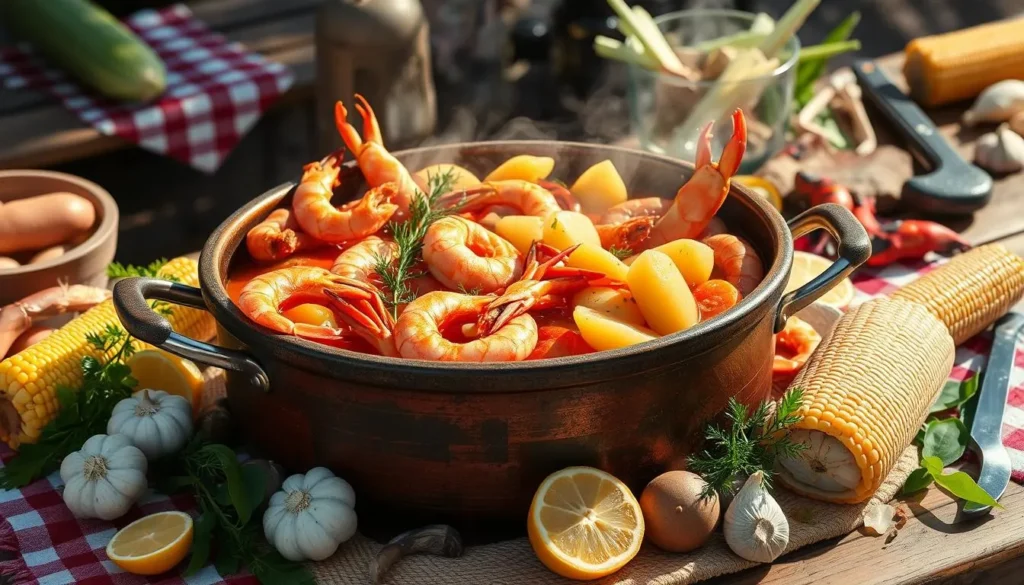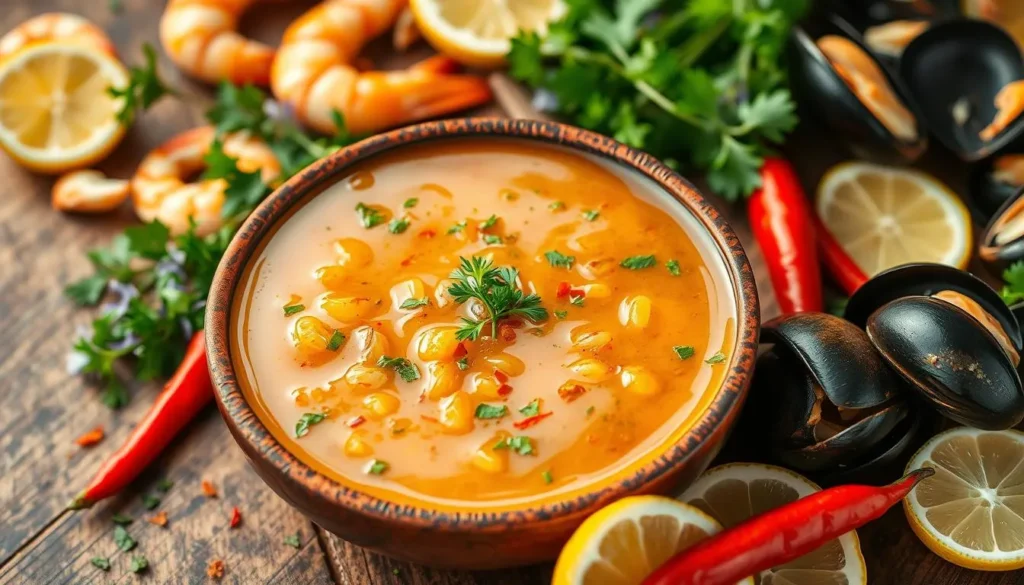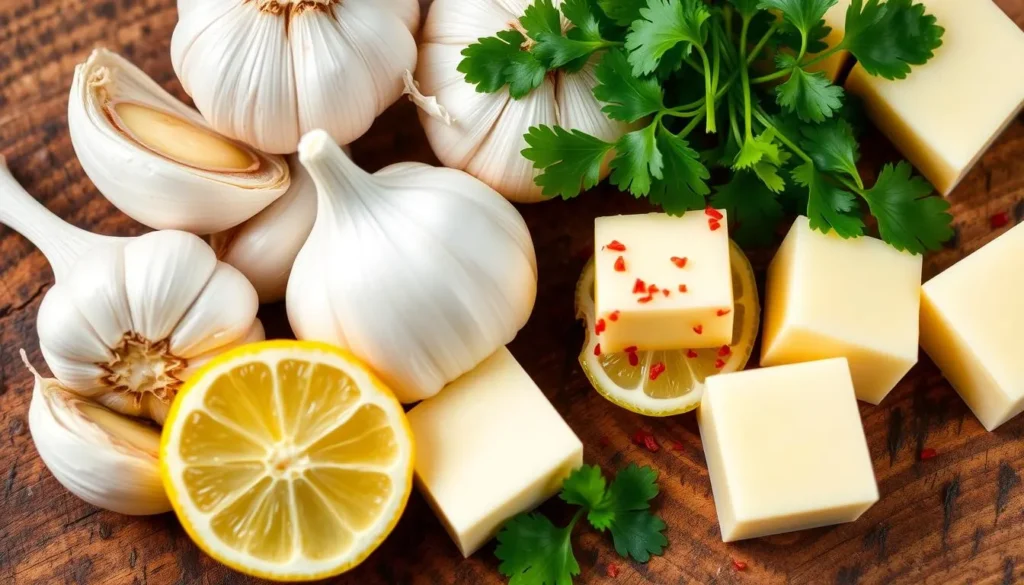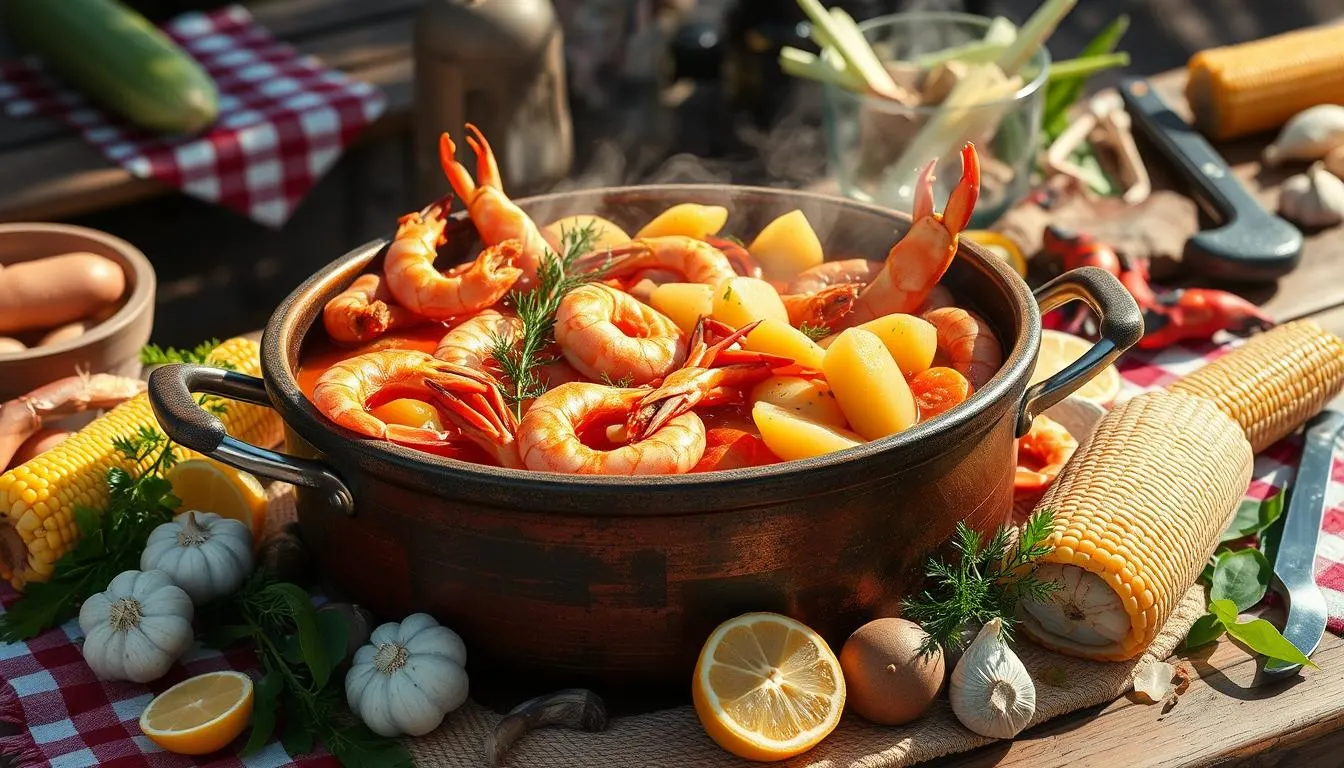As a passionate home cook, I know how much joy comes from making the perfect seafood dish. The sauce is key to a memorable seafood boil. It’s a mix of flavors that brings out the seafood’s natural sweetness. This sauce recipe will make your backyard gatherings or family dinners unforgettable.
Picture yourself biting into perfectly cooked shrimp, crab, or lobster. Each bite is filled with the rich, buttery taste of a well-made sauce. The mix of spices, tangy citrus, and smooth butter takes you to the South’s coastal areas, where seafood boils are a beloved tradition.

Key Takeaways
- Discover the secrets to creating a delicious seafood boil sauce
- Learn about the origins and key components of traditional seafood boil recipes
- Explore regional variations and influences that shape the perfect sauce
- Understand the role of essential ingredients like Cajun seasoning and Old Bay
- Unlock the techniques for mastering the perfect lemon garlic butter foundation
Understanding the Perfect Seafood Boil Sauce Recipe
Seafood boils are a cherished tradition, rooted in Cajun and Creole cuisines. The sauce at the heart of these feasts is a mix of flavors that makes them special.
Origins of Traditional Seafood Boil
The seafood boil comes from Louisiana’s Gulf Coast, influenced by Cajun and Creole cultures. These communities love fresh seafood and bold flavors. They’ve perfected the seafood boil over time, using cajun seasoning, old bay seasoning, and creole seasoning in the sauce.
Key Components of a Great Sauce
- Butter: The base of the sauce, adding creaminess.
- Garlic: Essential for depth and complexity in flavor.
- Spices: A mix of spices like paprika, cayenne, and black pepper for bold taste.
- Herbs: Fresh herbs like thyme, parsley, and bay leaves for fragrance and balance.
Regional Variations and Influences
Seafood boil sauces vary by region. In some places, old bay seasoning is key, while in others, cajun seasoning or creole seasoning are favored. These differences show the unique flavors and traditions of each area.

“The perfect seafood boil sauce is a harmonious blend of richness, spice, and regional flair, creating a truly indulgent and unforgettable dining experience.”
Essential Ingredients for Your Butter Sauce Base
Making a tasty seafood boil sauce begins with the butter sauce base. This part is key to the flavor. You need a few important ingredients to make a sauce that’s rich and goes well with seafood.
The base starts with butter. Choose butter with a lot of milk fat for a creamy feel. Use unsalted butter to control the salt.
Garlic is also crucial. Its strong smell and taste make the butter sauce better. Make sure to mince the garlic well for the best flavor.
Lemon juice is the last but not least ingredient. It adds a fresh, citrusy taste that balances the sauce’s richness. Start with a little and add more if you like.
Adding a bit of seafood broth can also boost the flavor. It makes the sauce more complex and seafood-like.

By using these key ingredients and finding the right mix, you’ll make a lemon garlic butter sauce. It will take your seafood boil to a whole new level of taste.
Mastering Cajun Seasoning Blends
Cajun cuisine is famous for its bold spice blends. These blends make seafood dishes even better. The key is the Cajun spice mix, a mix of aromatic and spicy ingredients.
Traditional Cajun Spice Mix
The classic Cajun spice mix has a few main ingredients:
- Paprika adds a smoky flavor
- Cayenne pepper gives a spicy kick
- Dried oregano and thyme add herbal notes
- Garlic and onion powder add savory depth
- Black pepper adds a peppery touch
By mixing these spices right, you get a Cajun seasoning that goes well with many seafood types. This includes shrimp, crawfish, crab, and lobster.
Heat Level Customization
Homemade Cajun seasoning lets you adjust the heat to your liking. If you like it milder, use less cayenne pepper. For more heat, add more cayenne. Find the heat and flavor mix that you enjoy the most.
Storage and Shelf Life Tips
To keep your Cajun seasoning fresh, store it in an airtight container. Keep it in a cool, dark place like a pantry. Homemade blends last 6 to 12 months, depending on the ingredients. Before using, shake the container well to mix the spices evenly.
The Role of Old Bay Seasoning in Seafood Boils
Old Bay seasoning is a key player in seafood boils. It comes from the Chesapeake Bay area and is loved for crab and shrimp boils. Its mix of spices, herbs, and celery salt brings out the seafood’s natural sweetness.
In a seafood boil, Old Bay seasoning makes the dish taste better. It adds warm, aromatic flavors to the broth. This makes every bite of crab or shrimp taste amazing.
To add Old Bay seasoning to your boil sauce, start with a lot in the butter or oil. The seasoning’s flavors will mix well with the other ingredients. You can also sprinkle it on the seafood before serving or use it to line the bowls.
| Ingredient | Quantity |
|---|---|
| Old Bay Seasoning | 2-3 tablespoons |
| Butter | 1 cup |
| Garlic, minced | 3 cloves |
| Lemon juice | 2 tablespoons |
Adding Old Bay seasoning to your seafood boil sauce makes for a memorable meal. It celebrates the flavors of coastal cuisine.
Creating the Perfect Lemon Garlic Butter Foundation
The base of a great seafood boil sauce is the lemon garlic butter mix. This blend adds a tasty mix of tangy, savory, and aromatic flavors to your seafood. Let’s dive into how to make this key part.
Garlic Preparation Methods
The quality of your garlic is key to the flavor of your lemon garlic butter. For a stronger taste, mince the garlic finely or roast it to bring out its sweetness. Or, you can sauté the garlic in the butter sauce until it’s soft and fragrant.
Butter Selection Guide
The butter you pick affects the sauce’s texture and richness. Choose unsalted butter for better control over the flavor. Salted butter works too, but watch out for extra sodium. Adding heavy cream or sour cream can make the sauce richer and creamier.
Citrus Integration Techniques
Citrus is important to balance the lemon garlic butter and keep it from getting too rich. Use lemon juice and zest to get the right mix of acidity and aroma. Start with a little lemon juice and add more until it’s just right. The zest adds a bright, fresh flavor.
Mastering these basics will help you make a lemon garlic butter sauce that will take your seafood boil to the next level.
Spicy Boil Sauce Variations
Explore the world of spicy boil sauce variations to elevate your seafood boil. Whether you love heat or prefer a balanced taste, there are many ways to customize your sauce. This lets you match your taste preferences perfectly.
To add a kick, try using spicy boil sauce. Mix in hot peppers like jalapeños, habaneros, or Scotch bonnets for the right heat. Blend these with cajun seasoning or creole seasoning for a perfect flavor balance.
For a more complex heat, mix different hot sauces. Try Tabasco for smoky and tangy, or Sriracha for fruity and fiery. Find the perfect mix that matches your taste.
| Hot Pepper | Scoville Heat Units (SHU) | Flavor Profile |
|---|---|---|
| Jalapeño | 2,500 – 8,000 SHU | Mild, slightly sweet, and slightly smoky |
| Habanero | 100,000 – 350,000 SHU | Fruity, with a citrusy and floral aroma |
| Scotch Bonnet | 100,000 – 350,000 SHU | Intense heat with a complex, almost sweet flavor |
When adding spice, balance the heat with flavors like garlic, lemon, and herbs. This makes your spicy boil sauce enjoyable and well-rounded.
“The key to a great spicy boil sauce is finding the right balance between heat and flavor. It’s a delicate dance, but when you nail it, the result is pure culinary bliss.”
Creole Seasoning vs Cajun: Understanding the Difference
When exploring seafood boil sauces, you’ll find Creole and Cajun seasoning blends. These come from Louisiana’s rich culture, each with its own taste. Knowing the difference between Creole and Cajun seasoning is key to making the best seafood boil sauce.
Historical Background
Cajun cuisine comes from the Acadians, French-speaking settlers from Canada. They settled in Louisiana in the 18th century. Their seasoning is bold and rustic. Creole cuisine, on the other hand, comes from New Orleans’ urban areas. It mixes French, Spanish, and African cooking styles.
Flavor Profile Comparison
Cajun seasoning and creole seasoning both use paprika, garlic, and onion. But their tastes are quite different. Cajun seasoning has a spicy kick from cayenne pepper or chili powder. Creole seasoning is more balanced, with thyme, oregano, and a hint of sweetness.
When picking between cajun seasoning and creole seasoning for your sauce, think about what you like. Cajun adds a strong kick. Creole offers a richer, more complex taste. Try both to see which suits your seafood best.
Seafood Broth Enhancement Techniques
Make your seafood boil sauce better by learning to make a tasty seafood broth. This key part adds depth and richness to your dish. Let’s look at how to make your seafood broth, crab boil, and shrimp boil dishes stand out.
Using shrimp shells and crab legs is a secret to a great seafood broth. These ingredients add lots of natural flavors to your sauce. Also, adding aromatic vegetables like onions, celery, and fennel boosts the flavor even more.
- Save shrimp shells and crab legs all year to always have them for your broth.
- First, sauté the shrimp shells and crab legs in oil or butter. This brings out their best flavors.
- Let the broth simmer for at least an hour. This lets the flavors mix well together.
After making your seafood broth, mix it into your seafood boil sauce. You can add some broth to your sauce or use it as the base. This creates a perfect blend of tastes.
“The secret to a truly exceptional seafood boil sauce lies in the depth of flavor of the seafood broth.”
By using these methods, your seafood boil sauce will be amazing. Your guests will love it so much, they’ll want more.
Make-Ahead and Storage Solutions
Creating the perfect seafood boil sauce recipe is easier with planning and proper storage. Whether for a special event or just to have ready, knowing how to prepare and store it is crucial. This keeps the flavors of your butter sauce delicious.
Proper Storage Methods
Let your seafood boil sauce cool down completely before storing it. Use glass jars or heavy-duty plastic bags for airtight storage. Make sure there’s some space left over for expansion.
Keep it in the fridge for up to a week or freeze it for up to 3 months.
Reheating Guidelines
- Thaw frozen sauce in the fridge overnight before reheating.
- Warm it up on the stovetop over medium heat, stirring now and then.
- Don’t let it boil too fast or get too hot, as it can ruin the sauce.
- If it’s too thick, add a little seafood broth or water to thin it out.
Follow these tips for making and storing your seafood boil sauce. This way, it stays creamy and flavorful. It will be a hit at your next seafood gathering.
Pairing Your Sauce with Different Seafoods
Choosing the right seafood boil sauce is key. With the right seafood boil sauce recipe, you can pair it with many seafoods. This makes for a memorable feast.
For a classic crab boil, the sauce is perfect. It matches the crab’s sweet flavor well. The Cajun spices and Old Bay enhance the crab’s taste, while the lemon-garlic butter adds a nice balance.
For shrimp boil, the sauce works great too. It coats the shrimp nicely. The spicy Cajun seasoning and the shrimp’s flavor make every bite exciting.
At a seafood boil with crawfish and lobster, the sauce shines. Just tweak the seasoning to match each seafood’s taste. The sauce will complement each one beautifully.
“The secret to a truly outstanding seafood boil is finding the perfect balance between the sauce and the seafood. With this recipe, you can achieve that balance every time.”
Make sure to offer lots of sauce for dipping and drizzling. This lets guests adjust the flavor to their liking. Everyone will leave happy and full.
Troubleshooting Common Sauce Issues
Making a tasty seafood boil sauce is an art. Even skilled cooks sometimes face problems. Don’t worry, we’ve got solutions for common sauce issues. This will help your butter sauce be its best.
Consistency Problems
Problems like a grainy sauce often come from bad emulsion or temperature changes. To fix this, slowly whisk the butter into the sauce. Make sure each bit is mixed in before adding more. Also, keep the heat low to keep your butter sauce smooth.
Flavor Balance Solutions
Finding the right mix of flavors in your seafood boil sauce recipe can be hard. If your sauce is off, try these tips:
- Too salty? A bit of lemon juice or vinegar can help.
- Too spicy? Sugar or honey can cool it down.
- Not rich enough? A little Worcestershire or soy sauce can add depth.
Remember, getting the seasoning right takes time. Keep tasting and adjusting until it’s just right for your seafood.
Learning to fix common sauce problems will make your butter sauce better. This will impress your guests and make your seafood boil even more special.
Related : Delicious Crab brulee Recipe: A Luxurious Seafood Treat
Conclusion
Creating a delicious seafood boil sauce is an art. It’s all about finding the right mix of flavors and textures. You’ve learned how to make a sauce that will wow your loved ones.
The secret to a great seafood boil sauce is using top-notch ingredients. Don’t be afraid to try new things, like adding a spicy kick or Creole flavors. With the tips from this article, you’re on your way to becoming a sauce expert.
Whether you’re having a big party or just want a cozy seafood meal, your homemade sauce will make it special. Use seafood boil sauce recipe, butter sauce, and Cajun seasoning to take your meal to the next level. Enjoy the journey of making a sauce that everyone will love.
FAQ
What is the essential base for a seafood boil sauce?
The base of a seafood boil sauce is a rich, flavorful butter sauce. It gives a smooth, creamy texture and a delicious buttery taste. This complements the seafood perfectly.
What are the key components of a great seafood boil sauce?
A great seafood boil sauce needs high-quality butter, fresh garlic, lemon juice, and aromatic spices. These include Cajun or Creole seasoning. Together, they create a balanced, flavorful sauce.
How can I customize the heat level in my seafood boil sauce?
To adjust the heat, use more or less spicy ingredients like cayenne pepper or hot sauce. Start with a small amount and add more to reach your desired heat. Make sure the spice doesn’t overpower the other flavors.
What is the difference between Cajun and Creole seasoning?
Cajun seasoning focuses on earthy spices like paprika, garlic, and cayenne. Creole seasoning has a wider range of herbs and spices, offering a more complex flavor.
How can I enhance the seafood flavor in my boil sauce?
To boost seafood flavor, add a flavorful seafood broth. Simmer shrimp shells or crab legs with veggies to make your own broth. This will enrich your sauce.
How can I make the seafood boil sauce ahead of time?
You can make seafood boil sauce ahead and store it. Cool it completely, then put it in an airtight container. Store it in the fridge for up to 5 days or freeze for 3 months. Reheat it gently before tossing with seafood.
How do I pair the perfect seafood boil sauce with different types of seafood?
Tailor the seafood boil sauce to match different seafood. A classic butter and garlic sauce is great with shrimp. For crawfish or crab, use a spicier Cajun-style sauce. Adjust the sauce to enhance the seafood’s natural flavors.

